Sony CDX-CA680X, CDX-L580X User Manual
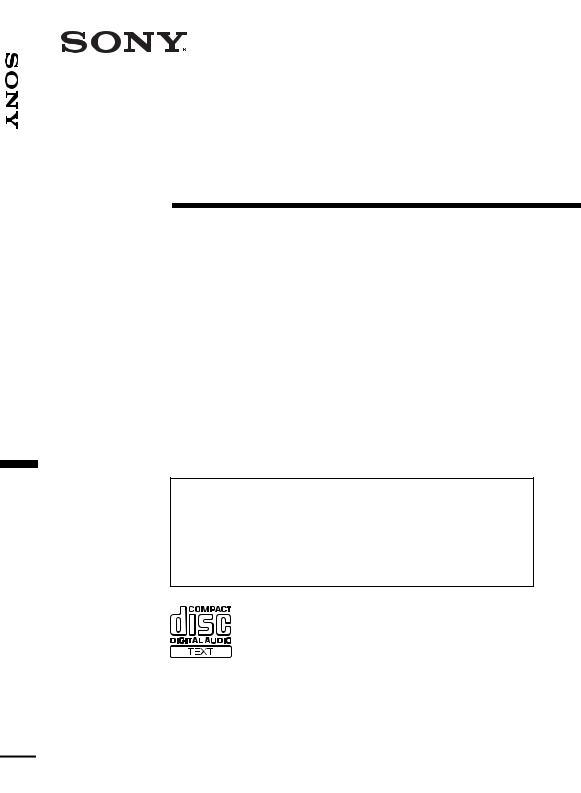
Player Disc Compact FM/MW/LW
3-247-306-11 (1)
FM/MW/LW
Compact Disc Player
Operating Instructions |
|
GB |
||||
|
|
|
|
|||
Bedienungsanleitung |
|
|
DE |
|||
|
|
|
||||
|
|
|
|
|
|
|
Mode d’emploi |
|
|
|
|
|
FR |
|
|
|
|
|
||
|
|
|
|
|
||
Istruzioni per l’uso |
|
|
|
|
IT |
|
|
|
|
|
|
||
Gebruiksaanwijzing |
|
|
|
NL |
||
|
|
|
||||
Wichtig!
Bitte nehmen Sie sich etwas Zeit, um den Geräte-Pass vollständig auszufüllen. Dieser befindet sich auf der hinteren Umschlagseite dieser Bedienungsanleitung.
Si dichiara che l’apparecchio è stato fabbricato in conformità all’art. 2, Comma 1 del D.M. 28.08. 1995 n. 548.
For installation and connections, see the supplied installation/connections manual.
Zur Installation und zum Anschluss siehe die mitgelieferte Installations-/Anschlussanleitung.
En ce qui concerne l’installation et les connexions, consulter le manuel d’installation/ raccordement fourni.
Per l’installazione e i collegamenti, fare riferimento al manuale di istruzioni per l’installazione e i collegamenti in dotazione.
Zie voor het monteren en aansluiten van het apparaat de bijgeleverde handleiding “Installatie en aansluitingen”.
CDX-CA680X
CDX-L580X
© 2003 Sony Corporation

Welcome !
Thank you for purchasing this Sony Compact Disc Player. You can enjoy its various features even more with:
•CD TEXT information (displayed when a CD TEXT disc*1 is played).
•Optional controller accessories
Card remote commander RM-X114 Rotary commander RM-X4S
CDX-CA680X only
Optional CD/MD units (both changers and players)*2.
*1 A CD TEXT disc is an audio CD that includes information such as the disc name, artist name, and track names. This information is recorded on the disc.
*2 This unit works with Sony products only.
This label is located on the bottom of the chassis.
CAUTION INVISIBLE LASER RADIATION WHEN OPEN DO NOT STARE INTO BEAM OR
VIEW DIRECTLY WITH OPTICAL INSTRUMENTS
This label is located on the drive unit’s internal chassis.
2

Table of Contents
Location of controls . . . . . . . . . . . . . . . . . . . 4 Precautions . . . . . . . . . . . . . . . . . . . . . . . . . . 5 Notes on discs . . . . . . . . . . . . . . . . . . . . . . . . 6
Getting Started
Resetting the unit . . . . . . . . . . . . . . . . . . . . . . 7 Detaching the front panel . . . . . . . . . . . . . . . 7 Setting the clock . . . . . . . . . . . . . . . . . . . . . . 8
CD Player
CD/MD Unit (optional) (CDX-CA680X)
Playing a disc. . . . . . . . . . . . . . . . . . . . . . . . . 9 Display items . . . . . . . . . . . . . . . . . . . . . . . . 10 Playing tracks repeatedly
— Repeat Play . . . . . . . . . . . . . . . . . . . . 10 Playing tracks in random order
— Shuffle Play . . . . . . . . . . . . . . . . . . . . 11 Labelling a CD
— Disc Memo*. . . . . . . . . . . . . . . . . . . . 11 Locating a disc by name
— List-up* . . . . . . . . . . . . . . . . . . . . . . . 12
* Functions available with optional CD/MD unit
CD Player (CDX-L580X)
Playing a disc. . . . . . . . . . . . . . . . . . . . . . . . 13 Display items . . . . . . . . . . . . . . . . . . . . . . . . 13 Playing tracks repeatedly
— Repeat Play . . . . . . . . . . . . . . . . . . . . 14 Playing tracks in random order
— Shuffle Play . . . . . . . . . . . . . . . . . . . . 14
Radio
Storing stations automatically
— Best Tuning Memory (BTM). . . . . . . 15 Receiving the stored stations . . . . . . . . . . . . 15 Storing only the desired stations . . . . . . . . . 16
RDS
Overview of RDS . . . . . . . . . . . . . . . . . . . . 16 Automatic retuning for best reception results
— AF (Alternative Frequencies) . . . . . . 17 Receiving traffic announcements
— TA (Traffic Announcement)/
TP (Traffic Programme) . . . . . . . . . . . . . 18 Presetting RDS stations with AF and TA
setting . . . . . . . . . . . . . . . . . . . . . . . . . . . 18 Tuning in stations by programme type
— PTY (Programme types) . . . . . . . . . . 19 Setting the clock automatically
— CT (Clock Time) . . . . . . . . . . . . . . . . 20
Other Functions
Using the rotary commander. . . . . . . . . . . . 20 Adjusting the balance and fader . . . . . . . . . 22 Quickly attenuating the sound . . . . . . . . . . 22 Changing the sound and display settings
— Menu . . . . . . . . . . . . . . . . . . . . . . . . . 22 Setting the equalizer (EQ3). . . . . . . . . . . . . 23 Setting the Dynamic Soundstage Organizer
(DSO) . . . . . . . . . . . . . . . . . . . . . . . . . . . 23
Additional Information
Maintenance . . . . . . . . . . . . . . . . . . . . . . . . 24 Removing the unit. . . . . . . . . . . . . . . . . . . . 25 Specifications . . . . . . . . . . . . . . . . . . . . . . . 26 Troubleshooting . . . . . . . . . . . . . . . . . . . . . 27 Error displays . . . . . . . . . . . . . . . . . . . . . . . 29
3
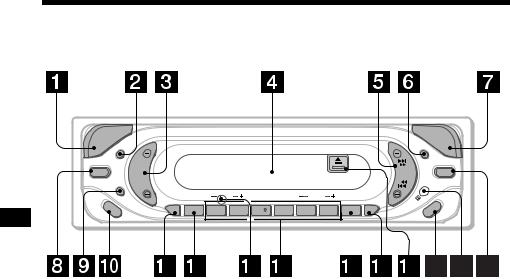
Location of controls
Refer to the pages listed for details.
|
E |
|
|
C |
|
|
R |
|
|
U |
|
S |
O |
SEL |
|
DSO
MODE |
ATT |
|
BTM |
|
DISC |
REP |
SHUF |
ALBUM |
|
LIST |
AF SENS |
1 |
2 |
3 |
4 |
5 |
6 |
PTY TA |
CDX-CA680X
|
O |
D |
P |
E |
|
S |
N |
P |
|
L |
|
SEEK EQ3
FF
O
a SOURCE (Power on/Radio/CD/MD*1) button
Selecting the source b SEL (select) button
Selecting items.
c Volume +/– button d Display window
eSEEK +/– button
Radio:
Tuning in stations automatically/finding a station manually.
CD (MP3 files*1)/MD*1:
Skipping tracks/fast-forwarding, reversing a
track.
fDSPL (display mode change) button
8, 10, 12, 13, 16
g OPEN button 7, 9, 13 h DSO button 23
i ATT (attenuate) button 22
jMODE button
Changing the operation
k AF button 17, 18
l SENS/BTM button 15, 16, 18
mRESET button (located on the front side of the unit, behind the front panel) 7
nNumber buttons
Radio:
Storing the desired station on each number button.
CD/MD*1:
(1): DISC –*1 9
(2): DISC +*1 9
(3): REP 10
(4): SHUF 11
MP3 files*1:
(5): ALBUM – 9
(6): ALBUM + 9
o PTY (programme type) /LIST*1 button
11, 12, 19
p TA button 18
q Z (eject) button (located on the front side of the unit, behind the front panel) 9
r OFF (Stop/Power off) button*2 7, 9, 13
sReceptor for the card remote commander
t EQ3 button 23
*1 CDX-CA680X only
*2 Warning when installing in a car without an ACC (accessory) position on the ignition switch
After turning off the ignition, be sure to press and hold (OFF) on the unit until the display disappears.
Otherwise, the display does not turn off and this causes battery drain.
4
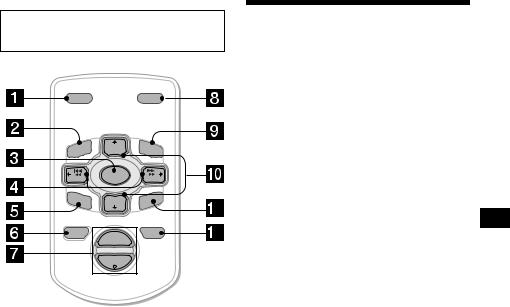
Card remote commander RM-X114 (optional)
DSPL |
|
MODE |
|
PRESET + |
|
MENU |
DISC + |
LIST |
SEEK– |
SOURCE |
SEEK+ |
|
||
SOUND |
DISC – |
ENTE |
|
|
R |
|
PRESET – |
|
OFF |
+ |
ATT |
|
VOL |
|
|
– |
|
The corresponding buttons of the card remote commander control the same functions as those on this unit.
a DSPL button b MENU button*1 c SOURCE button
d SEEK (</,) buttons e SOUND button
f OFF button
g VOL (+/–) buttons h MODE button
i LIST button*2
j DISC*2 (M/m) buttons k ENTER button
l ATT button
*1 Not available for this unit
*2 Not available for CDX-L580X
Note
If the display disappears by pressing (OFF), it cannot be operated with the card remote commander unless (SOURCE) on the unit is pressed, or a disc is inserted to activate the unit first.
Tip
Refer to “Replacing the lithium battery” for details on how to replace the batteries (page 24).
Precautions
•If your car has been parked in direct sunlight, allow the unit to cool off before operating it.
•Power aerial will extend automatically while the unit is operating.
•While driving, do not use the CUSTOM FILE feature or any other functions which may divert your attention from the road.
If you have any questions or problems concerning your unit that are not covered in this manual, please consult your nearest Sony dealer.
Moisture condensation
On a rainy day or in a very damp area, moisture condensation may occur inside the lenses and display of the unit. Should this occur, the unit will not operate properly. In such a case, remove the disc and wait for about an hour until the moisture has evaporated.
To maintain high sound quality
Be careful not to splash juice or other soft drinks onto the unit or discs.
5
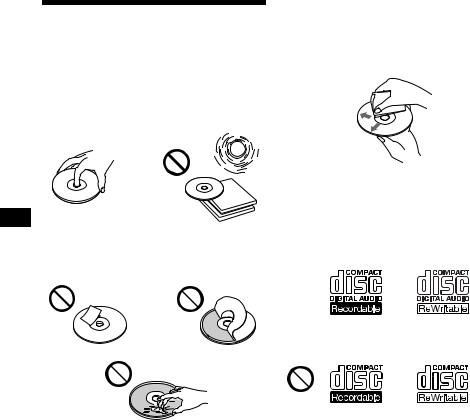
Notes on discs
•To keep the disc clean, do not touch the surface. Handle the disc by its edge.
•Keep your discs in their cases or disc magazines when not in use.
Do not subject the discs to heat/high temperature. Avoid leaving them in parked cars or on dashboards/rear trays.
•Do not attach labels, or use discs with sticky ink/residue. Such discs may stop spinning when used, causing a malfunction, or may ruin the disc.
•Before playing, clean the discs with a commercially available cleaning cloth. Wipe each disc from the centre out. Do not use solvents such as benzine, thinner, commercially available cleaners, or antistatic spray intended for analog discs.
Notes on CD-R/CD-RW discs
•You can play CD-Rs (recordable CDs)/CDRWs (rewritable CDs) designed for audio use on this unit.
Look for these marks to distinguish CD-Rs/ CD-RWs for audio use.
These marks denote that a disc is not for audio use.
•Do not use any discs with labels or stickers attached.
The following malfunctions may result from using such discs:
–Inability to eject a disc (due to a label or sticker peeling off and jamming the eject mechanism).
–Inability to read audio data correctly (e.g., playback skipping, or no playback) due to heat shrinking of a sticker or label causing a disc to warp.
•Discs with non-standard shapes (e.g., heart, square, star) cannot be played on this unit. Attempting to do so may damage the unit. Do not use such discs.
•You cannot play 8 cm CDs.
•Some CD-Rs/CD-RWs (depending on the equipment used for its recording or the condition of the disc) may not play on this unit.
•You cannot play a CD-R/a CD-RW that is not finalized*.
*A process necessary for a recorded CD-R/CD-RW disc to be played on the audio CD player.
6
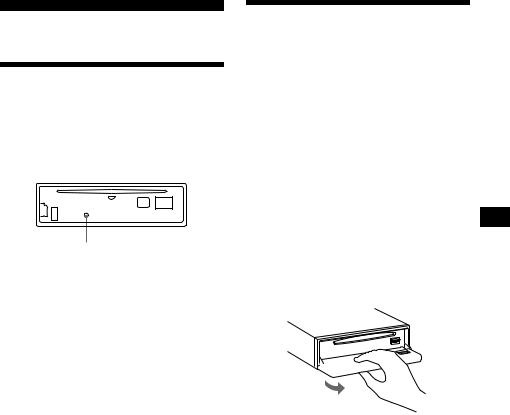
Getting Started
Resetting the unit
Before operating the unit for the first time, or after replacing the car battery or changing the connections, you must reset the unit.
Remove the front panel and press the RESET button with a pointed object, such as a ballpoint pen.
RESET button
Note
Pressing the RESET button will erase the clock setting and some stored contents.
Detaching the front panel
You can detach the front panel of this unit to protect the unit from being stolen.
Caution alarm
If you turn the ignition switch to the OFF position without removing the front panel, the caution alarm will beep for a few seconds.
If you connect an optional amplifier and do not use the built-in amplifier, the beep sound will be deactivated.
1 Press (OFF)*.
CD/MD playback or radio reception stops (the key illumination and display remain on).
*If your car has no ACC position on the ignition switch, be sure to turn the unit off by pressing (OFF) until the display disappears to avoid car battery drain.
2 Press (OPEN), then slide the front panel to the right, and gently pull out the left end of the front panel.
1


2
Notes
•If you detach the panel while the unit is still turned on, the power will turn off automatically to prevent the speakers from being damaged.
•Do not drop or put excessive pressure on the front panel and its display window.
•Do not subject the front panel to heat/high temperature or moisture. Avoid leaving it in a parked car or on a dashboard/rear tray.
Tip
When carrying the front panel with you, use the supplied front panel case.
continue to next page t
7

Attaching the front panel
Place hole A of the front panel onto the spindle B on the unit, then lightly push the left side in. Press (SOURCE) on the unit (or insert a CD) to operate the unit.
A
B
x
Note
Do not put anything on the inner surface of the front panel.
Setting the clock
The clock uses a 24-hour digital indication.
Example: To set the clock to 10:08
1 Press (DSPL) for 2 seconds.
The hour indication flashes.
1Press the volume +/– button to set the hour.
2Press (SEL).
The minute indication flashes.
3Press the volume +/– button to set the minute.
2 Press (DSPL).
The clock starts. After the clock setting is completed, the display returns to normal play mode.
Tip
You can set the clock automatically with the RDS feature (page 20).
8
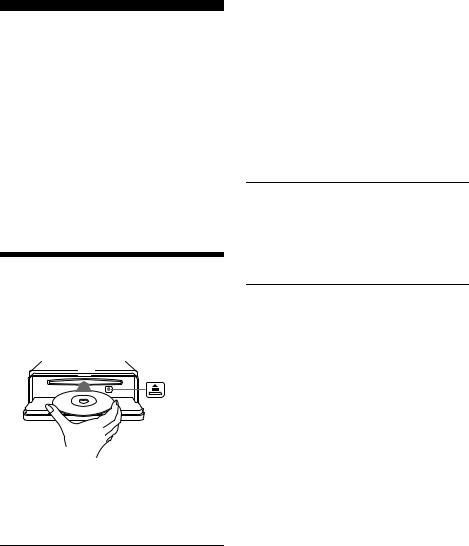
CD Player
CD/MD Unit (optional)
(CDX-CA680X)
In addition to playing a CD with this unit, you can also control external CD (MP3 playable CD)/ MD units. If you connect optional MP3 playable CD units (eg., MP3 CD changer), you can play MP3 files; compressed audio files (tracks) with quality of sound.
Note
If you connect an optional CD (MP3 playable CD) unit with the CD TEXT function, the CD TEXT information will appear in the display when you play a CD TEXT disc.
Playing a disc
(With this unit)
1 Press (OPEN) and insert the disc
(labelled side up).
2 Close the front panel.
Playback starts automatically.
If a disc is already inserted, press (SOURCE) repeatedly until “CD” appears to start playback.
To |
Press |
Stop playback |
(OFF) |
|
|
Eject the disc |
(OPEN) then Z |
|
|
Skip tracks |
(SEEK) (–/+) |
– Automatic |
(./>) |
Music Sensor |
[once for each track] |
|
|
Fast-forward/ |
(SEEK) (–/+) |
reverse |
(m/M) |
– Manual Search |
[hold to desired point] |
|
|
Notes
•While the first/last track on the disc is playing, if (SEEK) (+) or (SEEK) (–) is pressed, playback skips to the last/first track of the disc.
•When the last track on the disc is over, playback restarts from the first track of the disc.
(With optional unit)
1 Press (SOURCE) repeatedly to select “CD” or “MD (MS*1).”
2 Press (MODE) repeatedly until the desired unit appears.
Playback starts.
To |
Press |
|
|
Skip discs |
(1)(DISC–) or |
|
|
|
|||
– Disc selection |
(2)(DISC+) |
|
|
|
[once for each disc] |
|
|
|
|
|
|
Skip albums*2 |
(5)(ALBUM–) or |
|
|
– Albums selection (6)(ALBUM+) [hold to desired point]
*1 MS: MG Memory Stick System-up Player MGS-X1 *2 Available only when an MP3 file is played.
Albums are folders of a CD containing MP3 files.
Cautions when connecting MGS-X1 and MD unit(s)
This unit recognizes MGS-X1 as an MD unit.
•When you want to play MGS-X1, press (SOURCE) to select “MS” or “MD.” If “MS” appears in the source display, MGS-X1 starts to play. If “MD” appears in the source display, press (MODE) to select “MS,” to start playback.
•When you want to play an MD unit, press (SOURCE) to select “MD” or “MS.” If your desired MD unit appears in the source display, it starts to play. If “MS” or another MD unit appears in the source display, press (MODE) to select your desired MD unit, to start playback.
Notes when connecting MP3 playable CD unit(s)
•If a disc with no MP3 files (tracks) is inserted, “NO MUSIC” appears in the display and playback of the next disc starts.
•Before playing a track, this unit reads all track and album information on the disc. Depending on the track structure, it may take more than a minute before playback begins. During this time, “READ” is displayed. Please wait for play to start automatically when the reading is complete.
Note
With an optional unit connected, playback of the same source will continue on to the optional CD/MD unit.
9
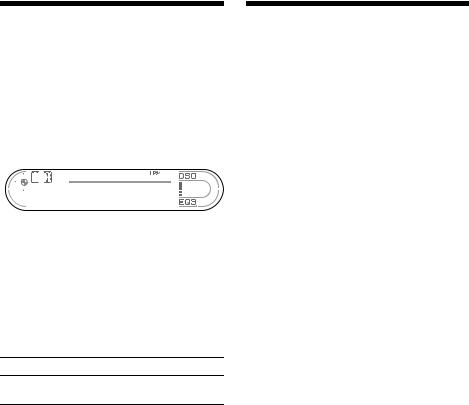
Display items
When the disc/album/track changes, any prerecorded title*1 of the new disc/album/track is automatically displayed (if the Auto Scroll function is set to “ON,” names exceeding 8 characters will be scrolled (page 22)).
|
|
|
|
|
|
|
|
MDLP display*2 |
||||||||
|
|
|
|
|
|
|
|
LP2: LP2 playback |
||||||||
|
|
Source |
|
LP4: LP4 playback |
||||||||||||
|
|
|
|
|
|
|
|
|
|
|
|
|
|
|
|
|
|
|
|
|
|
|
|
|
|
|
|
|
|
|
|
|
|
|
|
|
|
|
|
|
|
|
|
|
|
|
|
|
|
|
|
|
|
|
|
|
|
|
|
|
|
|
|
|
|
|
|
|
|
|
|
|
|
|
|
|
|
|
|
|
|
|
|
|
|
|
|
|
|
|
|
|
|
|
|
|
|
|
|
|
|
|
|
|
|
|
|
|
|
|
|
|
|
|
|
|
|
|
|
|
|
|
|
|
|
|
|
|
|
|
|
|
|
|
|
|
|
|
|
|
|
|
|
|
|
|
|
|
|
|
|
|
Disc/Album*3 |
Displayable items |
number |
• Track number/ |
|
|
|
Elapsed playing time |
|
• Disc name*1*4/Artist name*5 |
|
• Track name*1 |
|
• Album name*1*3 |
|
• ID3 tag*1*3 |
|
|
|
|
To |
Press |
Switch display item (DSPL)
Scroll display item (SEL) and (3) simultaneously
*1 When pressing (DSPL), “NO NAME”, indicates that there is no prerecorded name to display.
*2 Available only when optional MD unit with the MDLP function is connected, and an MDLP disc is played.
*3 Available only when an MP3 file is played.
*4 If the disc has been labelled by this unit using the CUSTOM FILE function, Disc Memo is displayed preferentially.
*5 Only for CD TEXT discs with the artist name.
Notes
•Some characters cannot be displayed. Characters and signs which cannot be displayed appear as “ *.”
•For some CD TEXT discs or ID3 tags with very many characters, information may not scroll.
•This unit cannot display the artist name for each track of a CD TEXT disc or an album.
Tip
When A.SCRL (Auto Scroll) is set to OFF and the disc/ album/track name is changed, the disc/album/track name or ID3 tag does not scroll.
Playing tracks repeatedly
— Repeat Play
The disc in the main unit will repeat a track, the entire album, or the entire disc when it reaches the end. For repeat play, you can select:
•REP-TRACK — to repeat a track.
•REP-ALBM*1 — to repeat an album.
•REP-DISC*2 — to repeat a disc.
*1 Available only when an MP3 file is played.
*2 Available only when one or more optional CD/MD units are connected.
During playback, press (3) (REP) repeatedly until the desired setting appears in the display.
Repeat Play starts.
To return to normal play mode, select “REP-OFF.”
10
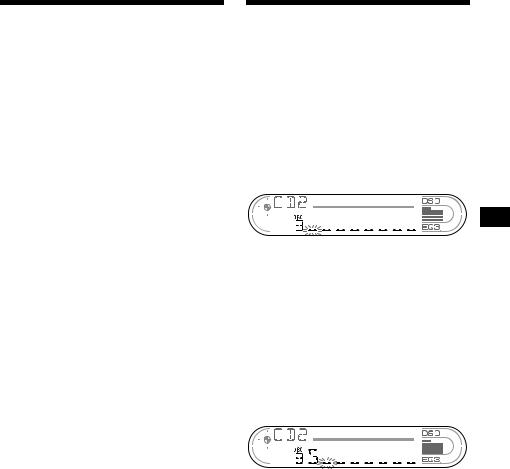
Playing tracks in random order
— Shuffle Play
You can select:
•SHUF-ALBM*1 — to play the MP3 files on an album in the current optional CD unit with the MP3 file control function in random order.
•SHUF-DISC — to play the tracks on the current disc in random order.
•SHUF-CHGR*2 — to play the tracks in the current optional CD (MD) unit in random order.
•SHUF-ALL*3 — to play all the tracks in all the connected CD (MD) units (including this unit) in random order.
*1 Available only when an MP3 file is played.
*2 Available only when one or more optional CD (MD) units are connected.
*3 Available only when one or more optional CD units, or two or more optional MD units are connected.
During playback, press (4) (SHUF) repeatedly until the desired setting appears in the display.
Shuffle Play starts.
To return to normal play mode, select “SHUF-OFF.”
Note
“SHUF-ALL” will not shuffle tracks between CD units and MD units.
Labelling a CD
— Disc Memo (For a CD unit with the CUSTOM FILE function)
You can label each disc with a custom name (Disc Memo). You can enter up to 8 characters for a disc. If you label a CD, you can locate the disc by name (page 12).
1 Start playing the disc you want to label in a CD unit with the CUSTOM FILE function.
2 Press (PTY) (LIST) for 2 seconds.
The unit will repeat the disc during the labelling procedure.
3 Enter the characters.
1Press the volume +/– button to select the desired character.
A y B y C ... y 0 y 1 y 2 ...
y + y – y * ... y  *1 y A
*1 y A
*1 (blank space)
2Press (SEL) after locating the desired character.
The next character flashes.
3Repeat steps 1 and 2 to enter the entire name.
4 To return to normal play mode, press (PTY) (LIST) for 2 seconds.
continue to next page t
11
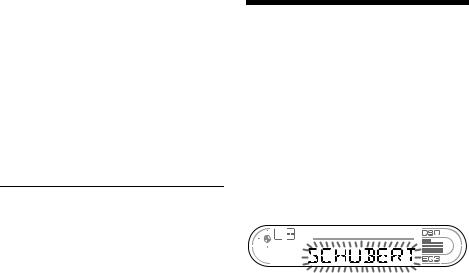
Tips
•Simply overwrite or enter “  ” to correct or erase a name.
” to correct or erase a name.
•You can label CDs on a unit without the CUSTOM FILE function if that unit is connected along with a CD unit that has the function. The Disc Memo will be stored in the memory of the CD unit with the CUSTOM FILE function.
Note
REP-TRACK/SHUF play is suspended until the Name Edit is complete.
Viewing the Disc Memo
As a display item, the Disc Memo always takes priority over any original CD TEXT information.
|
|
To |
Press |
|
|
View |
(DSPL) during CD/CD |
|
|||
|
|
|
TEXT disc playback |
|
|
|
|
|
|
|
|
Tip
Other items can be displayed (page 10).
Locating a disc by name
— List-up (For a CD unit with the CD TEXT/ CUSTOM FILE function, or an MD unit)
You can use this function for discs that have been assigned custom names*1 or for CD TEXT discs*2.
*1 Locating a disc by its custom name: when you assign a name for a CD (page 11) or an MD.
*2 Locating discs by the CD TEXT information: when you play a CD TEXT disc on a CD unit with the CD TEXT function.
1 Press (PTY) (LIST) momentarily.
The name assigned to the current disc appears in the display.
Erasing the Disc Memo
1 Press (SOURCE) repeatedly to select
“CD.”
2 Press (MODE) repeatedly to select the
CD unit storing the Disc Memo.
3 Press (PTY) (LIST) for 2 seconds.
4 Press (DSPL) for 2 seconds.
The stored names will appear.
5 Press the volume +/– button repeatedly to select the disc name you want to erase.
6 Press (SEL) for 2 seconds.
The name is erased.
Repeat steps 5 and 6 if you want to erase other names.
7 Press (PTY) (LIST) for 2 seconds.
The unit returns to normal play mode.
Notes
•When the Disc Memo for a CD TEXT disc is erased, the original CD TEXT information is displayed.
•If you cannot find the Disc Memo you want to erase, try selecting a different CD unit in step 2.
•If you have already erased all of the Disc Memo, the unit returns to normal CD play mode in step 4.
2 Press (PTY) (LIST) repeatedly until you find the desired disc.
3 Press (SEEK) (+) or (SEEK) (–) to play the disc.
Notes
•Once a disc name has been displayed for 5 seconds, the display goes back to its normal playback mode.
•The track names are not displayed during MD playback.
•If there are no discs in the magazine,"NO DISC" appears in the display.
•If a disc has not been assigned a custom file,"NO NAME" appears in the display.
•If the disc information has not been read by the unit, "NOT READ" appears in the display. To load the disc, first press the number button, then choose the disc that has not been loaded.
•The information appears only in upper cases. There are also some letters which cannot be displayed (during MD playback).
12
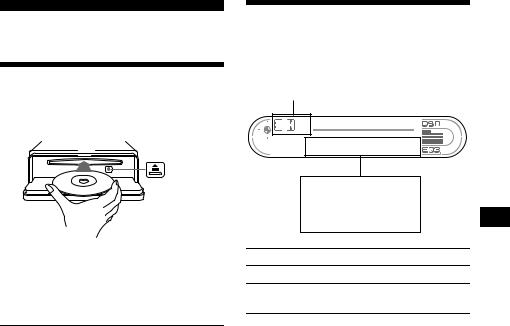
CD Player (CDX-L580X)
Playing a disc
1 Press (OPEN) and insert the disc
(labelled side up).
2 Close the front panel.
Playback starts automatically.
If a disc is already inserted, press (SOURCE) repeatedly until “CD” appears to start playback.
To |
Press |
Stop playback |
(OFF) |
|
|
Eject the disc |
(OPEN) then Z |
|
|
Skip tracks |
(SEEK) (–/+) |
– Automatic |
(./>) |
Music Sensor |
[once for each track] |
|
|
Fast-forward/ |
(SEEK) (–/+) |
reverse |
(m/M) |
– Manual Search |
[hold to desired point] |
|
|
Notes
•While the first/last track on the disc is playing, if (SEEK) (+) or (SEEK) (–) is pressed, playback skips to the last/first track of the disc.
•When the last track on the disc is over, playback restarts from the first track of the disc.
Display items
When the track changes, any prerecorded title* of the new track is automatically displayed (if the Auto Scroll function is set to “ON,” names exceeding 8 characters will be scrolled (page 22))
Source
Displayable items
•Track number/ Elapsed playing time
•Track name*
To |
Press |
Switch display item (DSPL)
Scroll display item (SEL) and (3) simultaneously
*When pressing (DSPL), “NO NAME” indicates that there is no prerecorded name to display.
Notes
•Some characters cannot be displayed. Characters and signs which cannot be displayed appear as “ *.”
•For some CD TEXT discs with very many characters, information may not scroll.
•This unit cannot display the artist name for each track of a CD TEXT disc.
Tip
When A.SCRL (Auto Scroll) is set to OFF and the disc/ track name is changed, the disc/track name does not scroll.
13

Playing tracks repeatedly
— Repeat Play
The current track will repeat itself when it reaches the end.
During playback, press (3) (REP) repeatedly until “REP-TRACK” appears in the display.
Repeat Play starts.
To return to normal play mode, select “REP-OFF.”
Playing tracks in random order
— Shuffle Play
You can select to play the tracks on the current disc in random order.
During playback, press (4) (SHUF) repeatedly until “SHUF-DISC” appears in the display.
Shuffle Play starts.
To return to normal play mode, select “SHUF-OFF.”
14
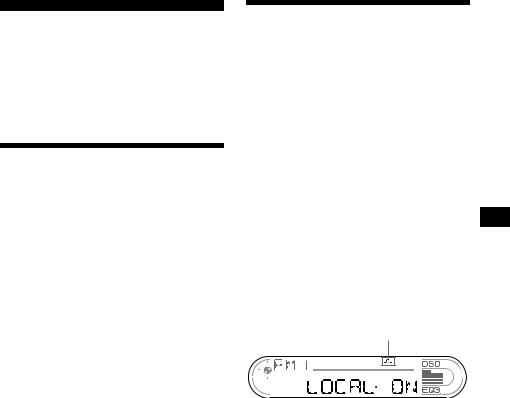
Radio
The unit can store up to 6 stations per band (FM1, FM2, FM3, MW, and LW).
Caution
When tuning in stations while driving, use Best Tuning Memory to prevent accidents.
Storing stations automatically
— Best Tuning Memory (BTM)
The unit selects the stations with the strongest signals within the selected band, and stores them in the order of their frequency.
1 Press (SOURCE) repeatedly to select the radio.
2 Press (MODE) repeatedly to select the band.
3 Press (SENS) (BTM) for 2 seconds.
The unit stores stations in the order of their frequencies on the number buttons.
A beep sounds when the setting is stored.
Notes
•If only a few stations can be received due to weak signals, some number buttons will retain their former settings.
•When a number is indicated in the display, the unit starts storing stations from the one currently displayed.
Receiving the stored stations
1 Press (SOURCE) repeatedly to select the radio.
2 Press (MODE) repeatedly to select the band.
3 Press the number button ((1) to (6)) on which the desired station is stored.
If preset tuning does not work
— Automatic tuning/Local Seek Mode
Automatic tuning:
Press (SEEK) (+) or (SEEK) (–) to search for the station.
Scanning stops when the unit receives a station. Repeat the operation until the desired station is received.
Local Seek Mode:
If the automatic tuning stops too frequently, press (SENS) (BTM) repeatedly until “LOCAL-ON” appears.
“LCL” indicator is displayed
Only the stations with relatively strong signals will be tuned in.
To cancel the local seek mode, select “LOCALOFF.”
Tip
If you know the frequency of the station you want to listen to, press and hold (SEEK) (+) or (SEEK) (–) to locate the approximate frequency, then press (SEEK) (+) or (SEEK) (–) repeatedly to fine adjust to the desired frequency (manual tuning).
continue to next page t
15
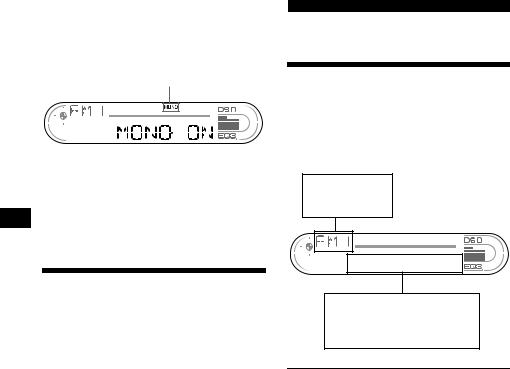
If FM stereo reception is poor
— Monaural Mode
During radio reception, press (SENS)
(BTM) repeatedly until “MONO-ON” appears.
“MONO” indicator is displayed
RDS
Overview of RDS
The sound improves, but becomes monaural (“ST” disappears).
To return to normal radio reception mode, select “MONO-OFF.”
Tip
If FM broadcasts are difficult to hear, set DSO to OFF (page 23).
Storing only the desired stations
You can manually preset the desired stations on any chosen number button.
1 Press (SOURCE) repeatedly to select the radio.
2 Press (MODE) repeatedly to select the band.
3 Press (SEEK) (+) or (SEEK) (–) to tune in the station that you want to store.
4 Press the desired number button ((1) to (6)) for 2 seconds until “MEM” appears.
The number button indication appears in the display.
Note
If you try to store another station on the same number button, the previously stored station will be erased.
FM stations with Radio Data System (RDS) service send inaudible digital information along with the regular radio programme signal. For example, one of the following will be displayed upon receiving a station with RDS capability.
Displayable items
•Music source
•Function
Displayable items
•Station name (frequency)
•Clock
•RDS data
To |
Press |
Switch Clock/ |
(DSPL) |
Station name |
|
|
|
RDS services
RDS data offers you other conveniences, such as:
•Automatic retuning of a programme, helpful during long-distance drives. — AF t page 17
•Receiving traffic announcements, even when enjoying another programme/source.
—TA t page 18
•Selecting stations by the type of programme
—PTY t page 19
•Automatic clock time setting. — CT t page 20
Notes
•Depending on the country or region, not all of the RDS functions are available.
•RDS may not work properly if the signal strength is weak or if the station you are tuned to is not transmitting RDS data.
16
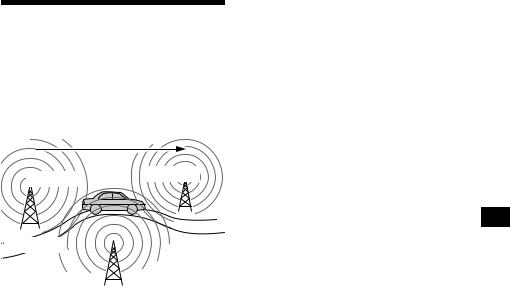
Automatic retuning for best reception results
— AF (Alternative Frequencies)
The AF function allows the radio to always tune into the area’s strongest signal for the station you are listening to.
Frequencies change automatically.
96.0 MHz
98.5 MHz
Station
102.5 MHz
1 Select an FM station (page 15).
2 Press (AF) repeatedly until “AF-ON” appears.
The unit starts searching for an alternative frequency with a stronger signal in the same network.
If “NO AF” flashes, the currently tuned into station does not have an alternative frequency.
Notes
•If you want to change the on/off setting while playing a CD, press (AF).
•When there is no alternative frequency in the area or when you do not need to search for one, turn the AF function off by selecting “AF-OFF.”
For stations without alternative frequencies
Press (SEEK) (+) or (SEEK) (–) while the station name is flashing (within 8 seconds).
The unit starts searching for another frequency with the same PI (Programme Identification) data (“PI SEEK” appears). If the unit cannot find the same PI, the unit returns to the previously selected frequency.
Staying with one regional programme
When AF function is on: this unit’s factory-set setting restricts reception to a specific region, so you won’t be switched to another regional station with a stronger frequency.
If you leave this regional programme’s reception area or would like to take advantage of the whole AF function, press (AF) for 2 seconds until “REG-OFF” appears.
Note
This function does not work in the United Kingdom and in some other areas.
Local Link function (United Kingdom only)
This function enables you to select other local stations in the area, even if they are not stored on your number buttons.
1 Press the number button ((1) to (6)) that has a local station stored on it.
2 Within 5 seconds, press the number button of the local station again.
3 Repeat this procedure until the desired local station is received.
17

Receiving traffic announcements
— TA (Traffic Announcement)/TP (Traffic
Programme)
By activating TA and TP, you can automatically tune in an FM station broadcasting traffic announcements. These settings function regardless of the current FM programme/source, CD/MD*; the unit switches back to the original source when the bulletin is over.
* CDX-CA680X only
Press (TA) repeatedly until “TA-ON” appears.
The unit starts searching for traffic information stations.
“TP” indicates reception of such stations, and “TA” flashes during an actual traffic announcement. The unit will continue searching for stations available with TP if “NO TP” is indicated.
To cancel all traffic announcements, select “TAOFF.”
To |
Press |
Cancel current |
(TA) |
announcement |
|
|
|
Tip
You can also cancel the current announcement by pressing (SOURCE) or (MODE).
Presetting the volume of traffic announcements
You can preset the volume level of the traffic announcements so you won’t miss hearing them.
1 Press the volume +/– button to adjust the desired volume level.
2 Press (TA) for 2 seconds.
“TA” appears and the setting is stored.
Receiving emergency announcements
If either AF or TA is on, the unit will switch to emergency announcements, if one comes in while listening to an FM station, or CD/MD*.
* CDX-CA680X only
Presetting RDS stations with AF and TA setting
When you preset RDS stations, the unit stores each station’s AF/TA setting (on/off) as well as its frequency. You can select a different setting (for AF, TA, or both) for individual preset stations, or the same setting for all preset stations. If you preset stations with “AF-ON” the unit automatically stores stations with the strongest radio signal.
Presetting the same setting for all preset stations
1 Select an FM band (page 15).
2 Press (AF) and/or (TA) to select “AF-
ON” and/or “TA-ON.”
Note that selecting “AF-OFF” and “TA-OFF” applies to non-RDS stations as well as RDS stations.
3 Press (SENS) (BTM) until “BTM” flashes.
Presetting different settings for each preset station
1 Select an FM band, and tune in the desired station (page 15).
2 Press (AF) and/or (TA) to select “AF-
ON” and/or “TA-ON.”
3 Press the desired number button ((1) to (6)) until “MEM” appears.
Repeat from step 1 to preset other stations.
Note
If you want to change the AF/TA setting while you are playing a CD, press (AF) or (TA).
18
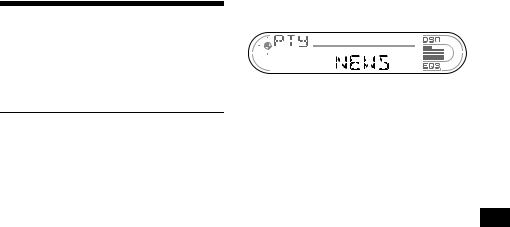
Tuning in stations by programme type
— PTY (Programme types)
You can tune in a station by selecting the type of programme you would like to listen to.
Programme types |
Display |
News |
NEWS |
|
|
Current Affairs |
AFFAIRS |
|
|
Information |
INFO |
|
|
Sports |
SPORT |
|
|
Education |
EDUCATE |
|
|
Drama |
DRAMA |
|
|
Culture |
CULTURE |
|
|
Science |
SCIENCE |
|
|
Varied |
VARIED |
|
|
Popular Music |
POP M |
|
|
Rock Music |
ROCK M |
|
|
Easy Listening |
EASY M |
|
|
Light Classical |
LIGHT M |
|
|
Classical |
CLASSICS |
|
|
Other Music Type |
OTHER M |
|
|
Weather |
WEATHER |
|
|
Finance |
FINANCE |
|
|
Children’s Programmes |
CHILDREN |
|
|
Social Affairs |
SOCIAL A |
|
|
Religion |
RELIGION |
|
|
Phone In |
PHONE IN |
|
|
Travel |
TRAVEL |
|
|
Leisure |
LEISURE |
|
|
Jazz Music |
JAZZ |
|
|
Country Music |
COUNTRY |
|
|
National Music |
NATION M |
|
|
Oldies Music |
OLDIES |
|
|
Folk Music |
FOLK M |
|
|
Documentary |
DOCUMENT |
|
|
Note
You cannot use this function in some countries where no PTY data is available.
1 Press (PTY) (LIST) during FM reception.
The current programme type name appears if the station is transmitting the PTY data. “--------” appears if the received station is not an RDS station, or if the RDS data is not received.
2 Press (PTY) (LIST) repeatedly until the desired programme type appears.
The programme types appear in the order shown in the table.
“NONE” appears if the programme type is not specified in the RDS data.
3 Press (SEEK) (+) or (SEEK) (–).
The unit starts searching for a station broadcasting the selected programme type.
19
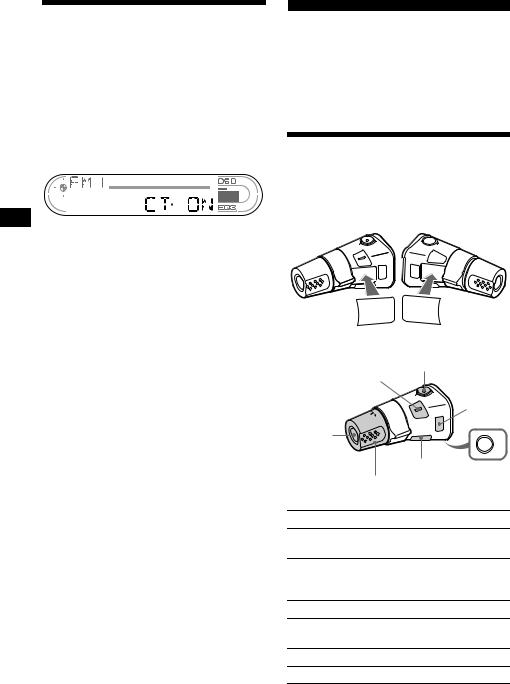
Setting the clock automatically
— CT (Clock Time)
The CT data from the RDS transmission sets the clock automatically.
Selecting “CT-ON”
During radio reception, press (SEL) and (2) simultaneously
The clock is set.
After one second, the display returns to normal radio reception mode.
To select “CT-OFF”, press (SEL) and (2) simultaneously again.
Notes
•The CT function may not work even though an RDS station is being received.
•There might be a difference between the time set by the CT function and the actual time.
Other Functions
You can also control the unit (and optional CD/ MD units*) with a rotary commander
(optional).
* CDX-CA680X only
Using the rotary commander
First, attach the appropriate label depending on how you want to mount the rotary commander. The rotary commander works by pressing buttons and/or rotating controls.
SEL |
DSPL |
MODE |
MODE |
DSPL |
SEL |
|
By pressing buttons
|
(ATT) |
|
|
(SEL) |
|
|
|
(MODE) |
(SOURCE) |
|
|
|
|
OFF |
|
(DSPL) |
(OFF) |
|
|
|
Rotate the VOL control |
|
|
to adjust the volume. |
|
|
Press |
To |
|
(SOURCE) |
Change source |
|
|
(radio/CD/MD*1)/Power on |
|
(MODE) |
Change operation |
|
|
(radio band/CD unit*1/ |
|
|
MD*1 unit) |
|
(ATT) |
Attenuate sound |
|
(OFF)*2 |
Stop playback or radio |
|
|
reception/Power off |
|
(SEL) |
Adjust and select |
|
(DSPL) |
Change the display item |
|
20
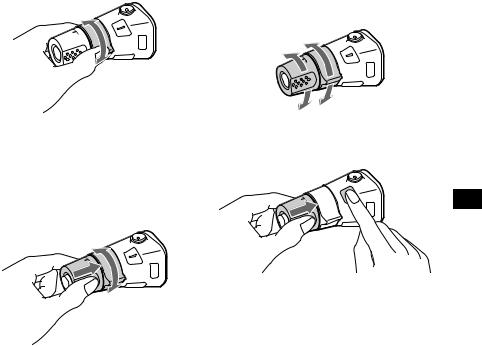
By rotating the control
SEEK/AMS control
Rotate and release to:
–Skip tracks.
–Tune in stations automatically.
Rotate, hold, and release to:
–Fast-forward/reverse a track.
–Find a station manually.
By pushing in and rotating the control
PRESET/DISC control
CDX-CA680X
Push in and rotate the control to:
–Receive preset stations.
–Change discs during CD (MD) playback*1.
During playback of a CD containing MP3 files*3
Push in and repeat rotating quickly to:
– Change discs one by one.
Push in, then rotate and hold to:
– Change albums.
CDX-L580X
Push in and rotate the control to:
– Receive preset stations.
*1 Only if the corresponding optional equipment is connected.
*2 If your car has no ACC (accessory) position on the ignition key switch, after turning off the ignition, be sure to press and hold (OFF) until the display disappears.
*3 Available only when optional CD unit with the MP3 file control function is connected.
Changing the operative direction
The operative direction of controls is factory-set as shown below.
To increase
To decrease
If you need to mount the rotary commander on the right hand side of the steering column, you can reverse the operative direction.
Press (SEL) for 2 seconds while pushing the VOL control.
21

Adjusting the balance and fader
You can adjust the balance and fader.
1 Press (SEL) repeatedly until “BAL” or
“FAD” appears.
Each time you press (SEL), the item changes as follows:
LOW* t MID* t HI* t
BAL (left-right) t FAD (front-rear)
* When EQ3 is activated (page 23).
2 Press the volume +/– button to adjust the selected item.
Note
Adjust within 3 seconds after selecting the item.
Quickly attenuating the sound
Press (ATT).
After “ATT-ON” momentarily appears, the “ATT” appears in the display.
To restore the previous volume level, press (ATT) again.
Tip
When the interface cable of a car telephone is connected to the ATT lead, the unit decreases the volume automatically when a telephone call comes in (Telephone ATT function).
Changing the sound and display settings
— Menu
The following items can be set:
SET (Set Up)
•CT (Clock Time) (page 20)
•A.SCRL (Auto Scroll)* (page 10).
•M.DSPL (Motion Display) — to select the Motion Display mode from “1,” “2,” and “OFF.”
–Select “1” to show decoration patterns in the display and activate Demo display.
–Select “2” to show decoration patterns in the display and deactivate Demo display.
–Select “OFF” to deactivate the Motion Display.
•BEEP — to turn the beeps on or off.
Selecting the desired item
Press (SEL) and the desired preset number button simultaneously.
(SEL) + (2): CT
(SEL) + (3): A.SCRL*
(SEL) + (4): M.DSPL
(SEL) + (6): BEEP
* When no CD is playing, this item will not appear.
After the mode setting completed, the display returns to normal play mode.
Note
The displayed item will differ depending on the source.
To cancel the item, press (SEL) and the preset number button simultaneously again.
22

Setting the equalizer (EQ3)
You can select an equalizer curve for 7 music types (XPLOD, VOCAL, CLUB, JAZZ, NEW AGE, ROCK, CUSTOM, and OFF (equalizer OFF)).
You can store a different equalizer setting for each source.
Selecting the equalizer curve
1 Press (SOURCE) to select a source
(radio, CD, or MD).
2 Press (EQ3) repeatedly until the desired equalizer curve appears.
Each time you press (EQ3), the item changes.
Setting the Dynamic
Soundstage Organizer (DSO)
If your speakers are installed into the lower part of the doors, the sound will come from below and may not be clear.
The DSO (Dynamic Soundstage Organizer) function creates a more ambient sound as if there were speakers above the dashboard (virtual speakers).
You can store the DSO setting for each source.
DSO mode and image of virtual speakers
*3 |
*3 |
|
*2 |
*2 |
|
*1 |
||
|
*1 
*4
*4
To cancel the equalizing effect, select “OFF.”
Adjusting the equalizer curve
You can store and adjust the equalizer settings for different tone ranges.
1 Press (SOURCE) to select a source
(radio, CD or MD).
2 Press (EQ3) repeatedly to select the desired equalizer curve.
3 Adjusting the equalizer curve.
1Press (SEL) repeatedly to select the desired tone range.
Each time you press (SEL), the tone range changes.
LOW t MID t HI (t BAL t FAD)
2Press the volume +/– button repeatedly to adjust to the desired volume level.
The volume level is adjustable by 1 dB steps from –10 dB to +10 dB.
3Repeat step 1 and 2 to adjust the equalizer curve.
To restore the factory-set equalizer curve, press (SEL) for 2 seconds.
After 3 seconds, the display returns to normal play mode.
Note
When EQ3 is set to “OFF,” you cannot adjust the equalizer settings.
*1 DSO-1
*2 DSO-2
*3 DSO-3
*4 DSO-OFF
1 Press (SOURCE) to select a source
(radio, CD, or MD).
2 Press (DSO) repeatedly until the desired DSO setting appears.
Each time you press (DSO), the DSO setting changes.
To cancel the DSO function, select “OFF.” After 3 seconds, the display returns to normal play mode.
Notes
•Depending on the type of car interior or type of music, DSO may not have a desirable affect.
•If FM broadcasts are difficult to hear, set DSO to OFF.
23
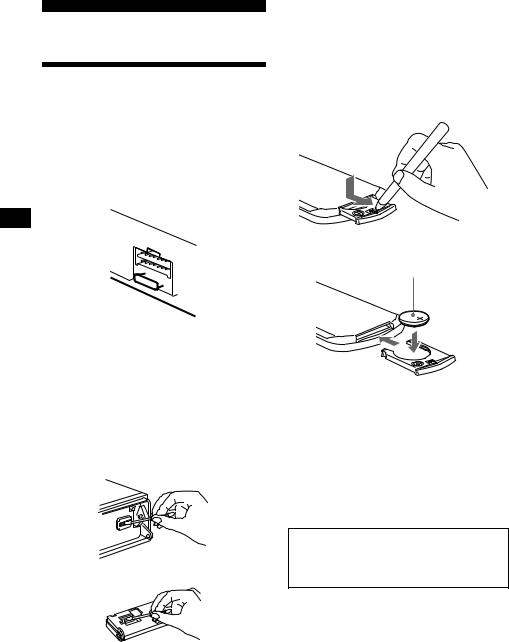
Additional Information
Maintenance
Fuse replacement
When replacing the fuse, be sure to use one matching the amperage rating stated on the original fuse. If the fuse blows, check the power connection and replace the fuse. If the fuse blows again after replacement, there may be an internal malfunction. In such a case, consult your nearest Sony dealer.

 Fuse (10 A)
Fuse (10 A)
Warning
Never use a fuse with an amperage rating exceeding the one supplied with the unit as this could damage the unit.
Cleaning the connectors
The unit may not function properly if the connectors between the unit and the front panel are not clean. In order to prevent this, detach the front panel (page 7) and clean the connectors with a cotton swab dipped in alcohol. Do not apply too much force. Otherwise, the connectors may be damaged.
Main unit
Back of the front panel
Notes
•For safety, turn off the ignition before cleaning the connectors, and remove the key from the ignition switch.
•Never touch the connectors directly with your fingers
24 or with any metal device.
Replacing the lithium battery
Under normal conditions, batteries will last approximately 1 year. (The service life may be shorter, depending on the conditions of use.) When the battery becomes weak, the range of the card remote commander becomes shorter. Replace the battery with a new CR2025 lithium battery. Use of any other battery may present a risk of fire or explosion.
x
+ side up
Notes on lithium battery
•Keep the lithium battery out of the reach of children. Should the battery be swallowed, immediately consult a doctor.
•Wipe the battery with a dry cloth to assure a good contact.
•Be sure to observe the correct polarity when installing the battery.
•Do not hold the battery with metallic tweezers, otherwise a short-circuit may occur.
WARNING
Battery may explode if mistreated.
Do not recharge, disassemble, or dispose of in fire.
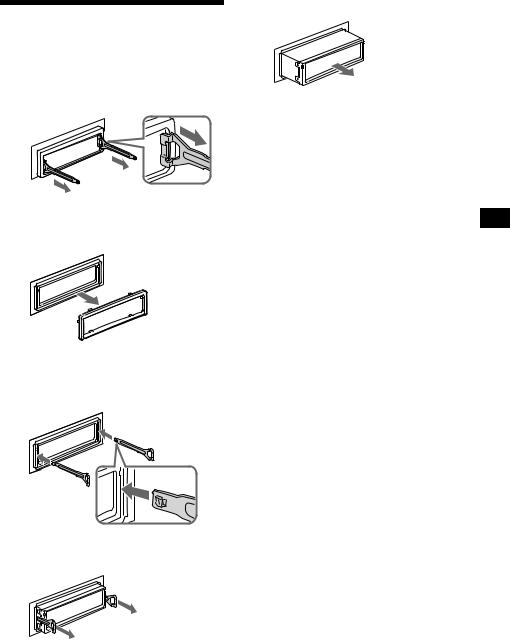
3Slide the unit out of the mounting.
Removing the unit
1 Remove the protection collar.
1Detach the front panel (page 7).
2Engage the release keys together with the protection collar.
Orient the release key correctly.
3Pull out the release keys to remove the protection collar.
2 Remove the unit.
1Insert both release keys together until they click.
Face the hook inwards.
2Pull the release keys to unseat the unit.
25

Specifications
CD Player section
Signal-to-noise ratio |
90 dB |
Frequency response |
10 – 20,000 Hz |
Wow and flutter |
Below measurable limit |
Tuner section
FM
|
Tuning range |
87.5 – 108.0 MHz |
|
Aerial terminal |
External aerial connector |
|
Intermediate frequency |
10.7 MHz/450 kHz |
|
Usable sensitivity |
9 dBf |
|
Selectivity |
75 dB at 400 kHz |
|
Signal-to-noise ratio |
67 dB (stereo), |
|
|
69 dB (mono) |
|
Harmonic distortion at 1 kHz |
|
|
|
0.5 % (stereo), |
|
|
0.3 % (mono) |
|
Separation |
35 dB at 1 kHz |
|
Frequency response |
30 – 15,000 Hz |
|
MW/LW |
|
|
Tuning range |
MW: 531 – 1,602 kHz |
|
|
LW: 153 – 279 kHz |
|
Aerial terminal |
External aerial connector |
|
Intermediate frequency |
10.7 MHz/450 kHz |
|
Sensitivity |
MW: 30 µV |
|
|
LW: 40 µV |
Power amplifier section
Outputs |
Speaker outputs |
|
(sure seal connectors) |
Speaker impedance |
4 – 8 ohms |
Maximum power output |
50 W × 4 (at 4 ohms) |
General
Outputs |
Audio outputs (front) |
|
(CDX-CA680X only) |
|
Audio outputs (rear) |
|
Power aerial relay control |
|
terminal |
|
Power amplifier control |
|
terminal |
Inputs |
Telephone ATT control |
|
terminal |
|
Remote controller input |
|
terminal |
|
BUS control input terminal |
|
(CDX-CA680X only) |
|
BUS audio input terminal |
|
(CDX-CA680X only) |
Tone controls |
Low ±10 dB at 60 Hz |
|
(XPLOD) |
|
Mid ±10 dB at 1 kHz |
|
(XPLOD) |
|
High ±10 dB at 10 kHz |
|
(XPLOD) |
Power requirements |
12 V DC car battery |
|
(negative earth) |
Dimensions |
Approx. 178 ×50 × 180 mm |
|
(w/h/d) |
Mounting dimensions |
Approx. 182 ×53 × 161 mm |
|
(w/h/d) |
Mass |
Approx. 1.2 kg |
Supplied accessories |
Parts for installation and |
|
connections |
|
Front panel case (1) |
Optional accessories |
Rotary commander |
|
RM-X4S |
Card remote commander RM-X114
Optional equipment (CDX-CA680X only)
CD changer (6 discs) CDX-T70MX, CDX-T69 MD changer (6 discs) MDX-66XLP
MG Memory Stick Systemup Player
MGS-X1 Source selector XA-C30
AUX-IN Selector XA-300
Note
This unit cannot be connected to a digital preamplifier or an equalizer which is Sony BUS system compatible.
Design and specifications are subject to change without notice.
26
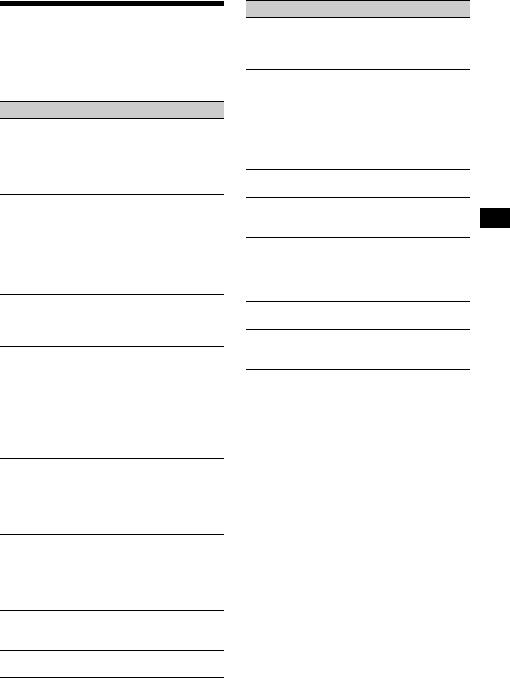
Troubleshooting
The following checklist will help you remedy problems you may encounter with your unit. Before going through the checklist below, check the connection and operating procedures.
General
No sound.
•Press the volume + button to adjust the volume.
•Cancel the ATT function.
•Set the fader control to the centre position for a 2-speaker system.
The contents of the memory have been erased.
•The RESET button has been pressed. t Store again into the memory.
•The power cord or battery has been disconnected.
•The power connecting cord is not connected properly.
No beep sound.
•The beep sound is cancelled (page 22).
•An optional power amplifier is connected and you are not using the built-in amplifier.
The display disappears from/does not appear in the display window.
•The display disappears if you press and hold
(OFF).
t Press and hold (OFF) again until the
display appears.
•Remove the front panel and clean the connectors. See “Cleaning the connectors” (page 24) for details.
Stored stations and correct time are erased. The fuse has blown.
Makes noise when the ignition key is in the ON, ACC, or OFF position.
The leads are not matched correctly with the car’s accessory power connector.
No power is being supplied to the unit.
•Check the connection. If everything is in order, check the fuse.
•The car does not have an ACC position.
t Press (SOURCE) (or insert a disc) to turn
on the unit.
The power is continuously supplied to the unit.
The car does not have an ACC position.
The power aerial does not extend.
The power aerial does not have a relay box.
CD/MD* playback
A disc cannot be loaded.
•Another CD/MD* is already loaded.
•The CD/MD* has been forcibly inserted upside down or in the wrong way.
Playback does not begin.
•Defective MD* or dirty CD.
•CD-R/CD-RW that is not finalized.
•You tried to playback a CD-R/CD-RW not designed for audio use.
•Some CD-Rs/CD-RWs may not play due to its recording equipment or the disc condition.
A disc is automatically ejected.
The ambient temperature exceeds 50°C.
The operation buttons do not function. CD will not be ejected.
Press the RESET button.
The sound skips from vibration.
•The unit is installed at an angle of more than 60°.
•The unit is not installed in a sturdy part of the car.
The sound skips.
Dirty or defective disc.
Cannot turn off the “-------- |
” indication.* |
You entered the name edit mode.
tPress (PTY) (LIST) for 2 seconds.
*CDX-CA680X only
continue to next page t
27
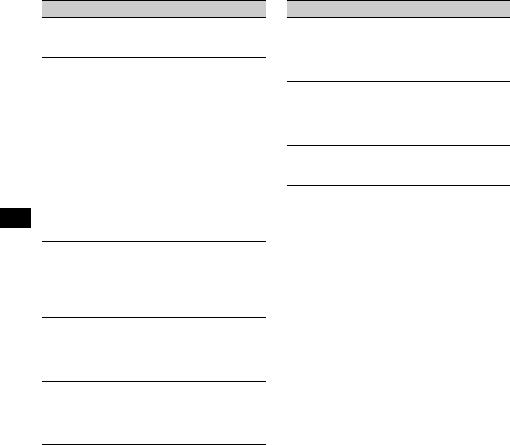
Radio reception
Preset tuning is not possible.
•Store the correct frequency in the memory.
•The broadcast signal is too weak.
The stations cannot be received. The sound is hampered by noises.
•Connect a power aerial control lead (blue) or accessory power supply lead (red) to the power supply lead of a car’s aerial booster. (Only when your car has built-in FM/MW/ LW aerial in the rear/side glass.)
•Check the connection of the car aerial.
•The auto aerial will not go up.
t Check the connection of the power aerial control lead.
•Check the frequency.
•When the DSO mode is on, the sound is sometimes hampered by noises.
t Set the DSO mode to “OFF” (page 23).
Automatic tuning is not possible.
•The local seek mode is set to “ON.”
t Set the local seek mode to “OFF” (page 15).
•The broadcast signal is too weak. t Perform manual tuning.
The “ST” indication flashes.
•Tune in the frequency accurately.
•The broadcast signal is too weak.
t Set the monaural reception mode to “ON” (page 16).
A programme broadcast in stereo is heard in monaural.
The unit is in monaural reception mode.
tCancel monaural reception mode (page 16).
RDS
The SEEK starts after a few seconds of listening.
The station is non-TP or has weak signal.
tPress (TA) repeatedly until “TA-OFF” appears.
No traffic announcements.
•Activate “TA.”
•The station does not broadcast any traffic announcements despite being TP.
t Tune in another station.
PTY displays “-------- |
.” |
•The current station is not an RDS station.
•RDS data has not been received.
28
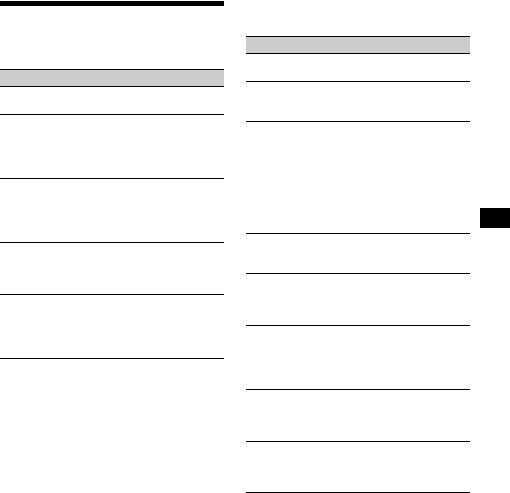
Error displays
For this unit
Error displays
The following indications will flash for about 5 seconds, and an alarm sound will be heard.
ERROR*1
•A CD is dirty or inserted upside down.*2 t Clean or insert the CD correctly.
•A CD cannot play because of some problem. t Insert another CD.
FAILURE
The connection of speakers/amplifiers is incorrect.
tSee the installation guide manual of this model to check the connection.
HI TEMP
The ambient temperature is more than 50°C.
tWait until the temperature goes down below 50°C.
OFFSET
There may be an internal malfunction.
tCheck the connection. If the error indication remains on in the display, consult your nearest Sony dealer.
For optional CD/MD changers (CDX-CA680X only)
Error displays
The following indications will flash for about 5 seconds, and an alarm sound will be heard.
BLANK*1
No tracks have been recorded on an MD.*2 t Play an MD with recorded tracks on it.
ERROR*1
•A CD is dirty or inserted upside down.*2 t Clean or insert the CD correctly.
•An MD does not playback because of some problem.*2
t Insert another MD.
•A CD/MD cannot play because of some problem.
t Insert another CD/MD.
NO DISC
No disc is inserted in the CD/MD unit. t Insert discs in the CD/MD unit.
NO MAG
The disc magazine is not inserted in the CD/ MD unit.
t Insert the magazine in the CD/MD unit.
NO MUSIC
A CD which is not a music file is inserted in the MP3 playable CD unit.
tInsert a music CD in the MP3 playable CD unit.
NOT READY
The lid of the MD unit is open or the MDs are not inserted properly.
t Close the lid or insert the MDs properly.
RESET
The CD/MD unit cannot be operated because of some problem.
t Press the RESET button on the unit.
*1 When an error occurs during playback of a CD or MD, the disc number of the CD or MD does not appear in the display.
*2 The disc number of the disc causing the error appears in the display.
If these solutions do not help improve the situation, consult your nearest Sony dealer.
29

Willkommen!
Danke, dass Sie sich für diesen CD-Player von Sony entschieden haben. Sie haben folgende zusätzliche Möglichkeiten, um die vielfältigen Funktionen des Geräts noch besser nutzen zu können:
•CD TEXT-Informationen (werden bei der Wiedergabe einer CD mit CD TEXT*1 angezeigt).
•Gesondert erhältliches Bedienungszubehör
Kartenfernbedienung RM-X114 Joystick RM-X4S
Nur CDX-CA680X
Gesondert erhältliche CD/MD-Geräte (Wechsler und Player)*2.
*1 Eine CD mit CD TEXT ist eine Audio-CD, die Informationen wie den Namen der CD, den Namen des Interpreten und die Namen der Titel enthält. Diese Daten sind auf der CD aufgezeichnet.
*2 Dieses Gerät arbeitet nur zusammen mit SonyProdukten.
Dieses Etikett befindet sich an der Unterseite des Gehäuses.
CAUTION INVISIBLE LASER RADIATION WHEN OPEN DO NOT STARE INTO BEAM OR
VIEW DIRECTLY WITH OPTICAL INSTRUMENTS
Dieses Etikett befindet sich am internen Chassis der Laufwerkseinheit.
2
